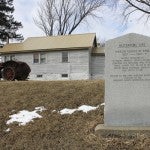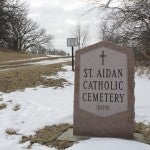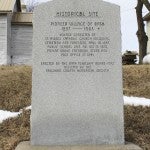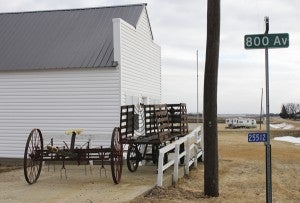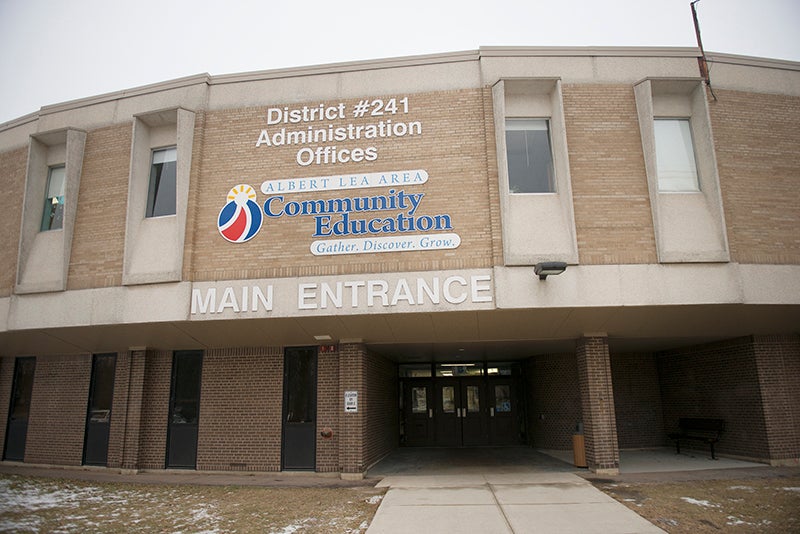Progress: Ghost towns
Published 2:59 pm Monday, April 16, 2012
One of the displays inside the entry to the Freeborn County Historical Museum is a large framed map with two sets of colored bulbs. The white bulbs show the present communities in the county. The red bulbs show the locations of places classified as “ghost towns.”
The usual concept of a ghost town is based on the image of a community that grew quickly a century or more ago, then gradually faded away and left a residue of a few abandoned buildings and maybe several older residents with faded memories of another era.
Each of the 13 former communities indicated on the museum‘s county map, plus four obscure towns that were overlooked, was based on a varying combination of a store or two, schoolhouse, creamery, a few residences and hopes of future growth. Several of these localities were also viable enough at one time to have post offices.
Bancroft
This name is still a viable part of Freeborn County as both a locality and official name for a township. And when the town of Bancroft was organized in 1856, it quickly became one of the serious contenders for the county seat. Now a portion of the village site, the Good Samaritan Center, is at the very northern end of the city limits of Albert Lea.
At one time Bancroft had a newspaper, a sawmill, town hall, post office, a famous creamery, a saloon and a general store near the crossroads of County Roads 22 and 14. Despite the designation of ghost town, this locality now is the site of several residences and may have the about the same population it had a century ago.
Bath
This was one of three localities in Freeborn County settled by immigrants from Ireland.
The name of Bath, which is actually based on an English city and a town in Maine, is now used as the name for a Freeborn County township and to designate the former community at the junction of County Roads 20 and 35.
At one time Bath had a post office, which opened for a few years after 1891, a creamery, store, a school and St. Aiden’s Catholic Church. The church was relocated to Ellendale in 1958.
Now the only reminders of the community and its Irish heritage are several older buildings located near the crossroads, plus the nearby cemetery behind the former location of the church.
A marker placed near the crossroads by the Freeborn County Historical Society listed the years of 1857 to 1963 for Bath’s existence as a town.
Buckeye
The name for this community in the southeast comer of Manchester Township came about because one of the pioneers who moved to this part of the county in 1858 was from Ohio. About all that made this particular place a community at all was its status as an official post office address from 1858 to 1870.
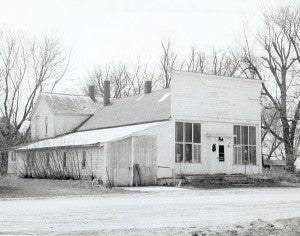
The former village of Deer Creek was just to the west of Freeborn County Road 32 and Deer Creek Valley Lutheran Church in London Township. This building was the former store and located on the Iowa side of the road. It’s no longer there and the only reminder of this part of the village is a Worth County historical marker. Just a portion of the creamery and a prize-winning 4-H park is on the Minnesota side. — photo courtesy Freeborn County Historical Museum
This is one of the four places not shown on the museum’s map.
Crayon Park
This particular ghost town is also not marked on the museum’s map. However, the name is listed under the category of other villages from the past on page 372 in the 1911 history book of Freeborn County. This is really a ghost town because the history book says, “Crayon Park is located in the central part of Section 6, of Oakland Township,” and that’s all.
The actual location of this alleged locality is likely in a field about two miles straight east of Petran’s Corner and the Oakland exit on Interstate 90.
Deer Creek
This particular place is the closest to the concept of a ghost town anywhere in this part of the nation because several of the abandoned buildings are still a part of the landscape.
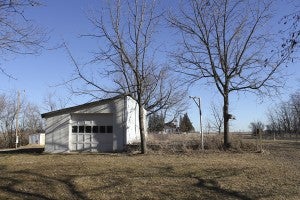
A lean-to garage is a reminder of the store that once stood at Deer Creek. A sign nearby notes the park was built by a 4-H Club but also notes the land is private property. — Tim Engstrom
Deer Creek was located in London Township right on the state line. Thus, a part of the community was in Minnesota, and the other half was in Iowa.
This town started about 1875, and by 1900 had a church, a store (with post office for a few years), a creamery, a harness shop, a blacksmith shop and several residences and nearby farm places.
To add a slight degree of confusion, there’s another locality with the name of Deer Creek in the state. This other Deer Creek is located in Otter Tail County west of Wadena and has a population of just over 300 people.
Dorwart
This nearly forgotten community isn’t shown on the museum’s map and probably had the shortest life of any locality in Freeborn County. Dorwart started as a depot and rail siding a mile south of Clarks Grove in 1900. and was a creation of the Burlington, Cedar Rapids & Northern Railroad. The promoters of this community filed documents with the county recorder, which platted 56 residential and business lots to the east of the railroad tracks.
In June 1902, the Chicago, Rock Island & Pacific Railroad took over the rail line running north out of Albert Lea. This firm quickly closed the Dorwart depot and made Clarks Grove the main train stop in this part of the county.
Other than an article in the Jan. 6, 1985, issue of the Tribune written by John Groten of Albert Lea, very little has ever been reported about this attempt to start a town. It’s not shown on the museum’s map of ghost towns.
The golf course south of Clarks Grove now occupies part of the area intended to become Dorwart.
Fairfield
This is still another ghost town not shown on the museum’s map. However, the site of Fairfield in Riceland Township has been designated with a marker placed by the Freeborn County Historical Society. The marker indicates this town existed from 1857 to I860.
Fairfield was organized by several promoters who anticipated that it would become a community that would grow with the arrival of a proposed railroad from the east. During its three years of existence, Fairfield had a sawmill, a store with post office, a blacksmith shop and four homes.
There is a Fairfield ghost town in Swift County, too.
Itasca
This community was one of the very first in Freeborn County and soon became a strong contender for the location of the courthouse.
The area known as Itasca was first settled in 1855 and officially platted as a village in 1857. By 1860, the community had a hotel, a general store, a dry goods store, a blacksmith shop, a shoemaker’s shop, a post office, a photography gallery, a dentist, a newspaper and 15 homes. After November 1860, when Itasca lost an election to Albert Lea to become the county seat, the town gradually declined.
Today, the former Wedge Nursery occupies part of the old village area. Not far away is the Itasca Cemetery, started in 1861 and still maintained as a pioneer legacy by a group of volunteers. Also in this area is the former Itasca School (now a private residence) and the impressive Itasca Rock Garden, created in the 1920s.
Knatvold
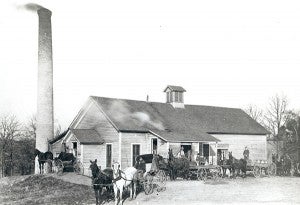
The creamery at the village of Knatvold was operated by the Freeman Cooperative Creamery Association from 1900 to 1914. According to the late Bidney Bergie, this creamery had a tall pipe smokestack, which was soon replaced with a brick chimney. — photo courtesy Freeborn County Historical Museum
A marker placed at the former site of Knatvold in Freeman Township lists 1900 to 1922 as the years of existence for this community straight south of Albert Lea.
The original name of this community came into existence as Oslo, but in early 1890 it was Freeman, the same as the surrounding township. However, the name of the post office was changed in 1900 to honor state Sen. Thorvald V. Knatvold. The village eventually consisted of a town hall, a small creamery, and a general store. The post office was discontinued; the creamery closed in 1914; and the store lasted until 1918. Now all that remains at the site of Knatvold today is the Freeman Township Hall.
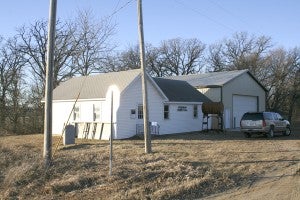
Knatvold today is the site of the Freeman Town Hall. The location still has an abundance of tall trees. Some perhaps appear in both photos. — Tim Engstrom
Lerdal
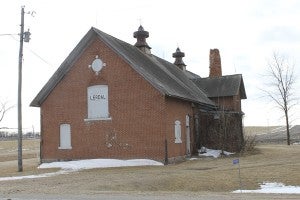
Lerdal, at County Road 25 and gravel 800th Avenue, still has a few of its buildings. The former creamery has the town name on it. — Tim Engstrom
This small community in Riceland Township was built around a creamery which started in 1890, according to several county history books: In time, a general store, telephone exchange, town hall, harness shop, shoe shop, blacksmith shop, a post office, and several homes comprised the village.
All the business firms, plus the post office, eventually ceased operations. The creamery continued to operate until 1958. In fact, that building and several of residences still constitute the community shown on county maps as Lerdal.
Moscow
When Soviet President Mikhail Gorbachev came to Minnesota for a short official visit in May 1990, an invitation was extended to him by the members of the Moscow Township board to visit their community. The closest the Soviet leader got to the place was the south end of Minneapolis.
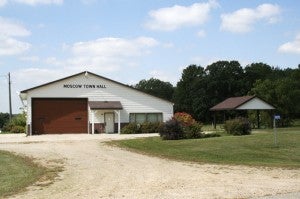
Moscow Town Hall and a small park now mark the location of the place called Moscow, photographed here in September 2009. — Tim Engstrom
The town and the township were reportedly named as the result of a fire in the oak woods in 1857. The huge fire supposedly reminded someone of the burning of the city in Russia by Napoleon in 1812.
During its glory days in the early part of this century Moscow had a flour mill, a post office, a general store, a blacksmith shop, a schoolhouse, a sawmill, a hotel and a creamery. Now all that’s left are the former store building, the abandoned creamery and a few homes near the intersection of County Roads 25 and 34.
Newry
The northeastern portion of Freeborn County was one of three areas settled by immigrants from Ireland. (The other two localities were Bath and Twin Lakes.) In fact, the name of the former town and present township are based on that of a small city in Ireland.
The center of this community is St. Mary’s Catholic Church, which was officially organized in 1892. At one time a store with post office and a creamery were also a pan of Newry.
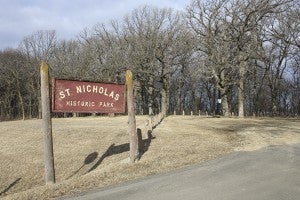
A park and a boat landing are both named for the town that once existed on the southeast side of Albert Lea Lake. — Tim Engstrom
St. Nicholas
A historical marker, a park area and a boat landing mark the location of Freeborn County’s first community, which was organized in May 1855 by Jacob Ly Brand and Samuel M. Thompson on the south side of Albert Lea Lake.
Their town was the location of the county’s first blacksmith shop, first post office — which operated from 1856 to 1858 — first hotel and first general store. The new community was an early contender for becoming the county seat. However, the focus of settlement shifted to the northwest to the town of Albert Lea Lake (which became Albert Lea) and by 1862 St. Nicholas had faded away.
For many years a place known as the Pierce Sisters Farm occupied the site of the former village, and their home included a portion of the pioneer hotel structure.
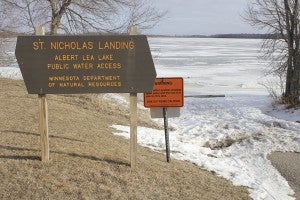
A park and a boat landing, shown in the photo above, are both named for the town that once existed on the southeast side of Albert Lea Lake. — Tim Engstrom
Another St. Nicholas was created in the 1950s about six miles to the north on what was then U.S. Highway 16 between Hayward and Albert Lea. This roadside locality became a tourist-type attraction and featured an ersatz pioneer village and small museum. It became the equivalent of a ghost town when most of the traffic was diverted onto Interstate 90 and a good portion of the artifacts were sold at an auction in 1984. Most of the buildings of the newer St. Nicholas creation are still in place beside what’s now County Road 46.
The city limits of Albert Lea are extended to the southeast almost to the edge of what was once the pioneer village of St. Nicholas to include a portion of a residential area along South Shore Drive.
Sigsbee
This nearly forgotten community was located in the southeast corner of Moscow Township. At one time there was a building that was a combination of store, residence and post office, plus a nearby creamery. The post office was established in the 1880s and discontinued by 1900. The store continued operations until the early 1940s. The building was then torn down and part of the lumber was used to build a home in Hayward.
Sumner
A marker placed at the site of Sumner by the Freeborn County Historical Society gives the dates of 1857 to 1876 as the years of existence for this pioneer village, which was also located in Moscow Township not too far from Sigsbee. The dates of 1857 to 1876 also coincide with the existence of the Sumner post office.
The town was a stagecoach stop between Albert Lea and Austin and had a school, a church and several residences. In time, the hopes for a larger town faded and the area once intended to become streets and residential lots became farm fields instead.
Trenton
A place called Trenton Lake in Freeborn Township and some fading memories are all that’s left of a town called Trenton which existed from 1857 to about 1900. A school building, a church, a post office that served the area for 30 years, a store, a creamery that closed in 1907 and some nearby residences and farm places constituted what’s now just another ghost town located straight north of Freeborn.


